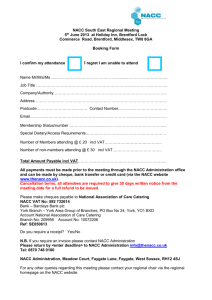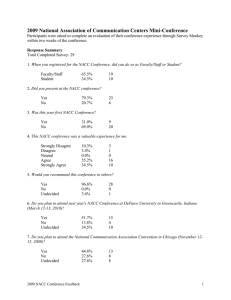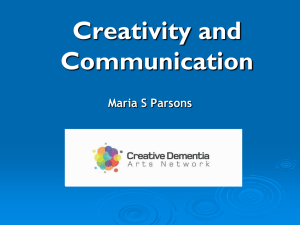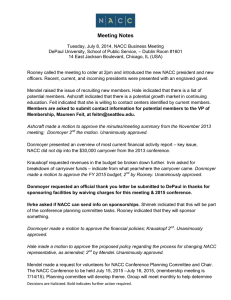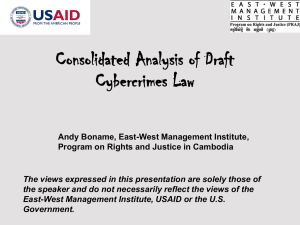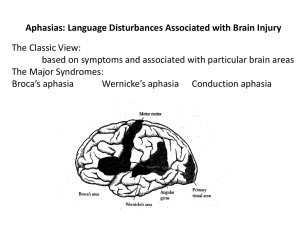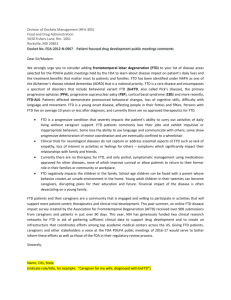sapolsky_ftdupdate_mar2011
advertisement
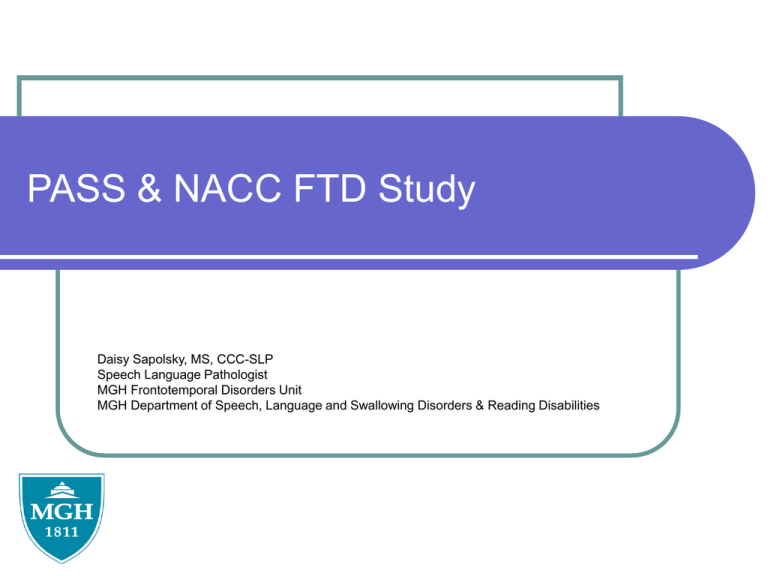
PASS & NACC FTD Study Daisy Sapolsky, MS, CCC-SLP Speech Language Pathologist MGH Frontotemporal Disorders Unit MGH Department of Speech, Language and Swallowing Disorders & Reading Disabilities National Alzheimer’s Coordinating Center (NACC) NACC overview: Alzheimer’s Disease Centers (ADCs) were established in 1984 NACC was then established in 1999 by the National Institute on Aging MGH was one of the first five to receive grants To facilitate collaborative research among the 29 ADCs nationwide NACC maintains a large database of the data collected at these visits, which is a valuable resource for ongoing research http://www.alz.washington.edu/ National Alzheimer’s Coordinating Center (NACC) NACC overview: Participation in NACC involves annual visits neurological examination and interview neuropsychological testing interview with a relative/friend MGH NACC cohort includes: 709 people being actively followed 320 people with normal cognition 330 people with some form of MCI 266 people with some form of dementia NACC FTD Study NACC FTD study: In pilot phase for the past year (6 centers) MGH ready to begin administration of the NACC FTD module Goals: To capture the cognitive changes of FTD through use of a tailored evaluation To collect uniform data on patients with FTD from centers across the country data may be helpful in clinical trial design Clinical Dementia Rating (CDR) Tools for quantifying severity and progression of dementia: Clinical Dementia Rating (CDR) 5-point scale to rate stages of dementia no cognitive impairment to severe impairment six domains of functioning are assessed through interview and patient performance on testing Memory, Orientation, Judgment and Problem solving, Community Affairs, Home and Hobbies, Personal Care two supplemental domains added in 2006: behavior and language Progressive Aphasia Severity Scale (PASS) PASS (2008) A “big picture” clinical tool to rate symptom severity in a variety of speech/language domains in people with progressive aphasia Modeled after the CDR supplemental language box, a rating of overall language impairment Clinicians use their judgment to rate presence and severity of impairment in each domain, capturing change from the patient’s baseline Progressive Aphasia Severity Scale (PASS) Captures information about symptoms, whereas performance-based testing captures signs of impairment; Presumably the two together will provide more information than either alone Some patients perform surprisingly better on testing than in daily life; Others are much more capable of communicating in conversation than they are of performing on tests Progressive Aphasia Severity Scale (PASS) All domains rated from normal to severe impairment, like the CDR: 0 (normal), 0.5 (questionable), 1 (mild), 2 (moderate), 3 (severe) Articulation Syntax/grammar Fluency Word retrieval and expression Repetition Auditory comprehension Single word comprehension Reading Writing Functional communication Progressive Aphasia Severity Scale (PASS) Progressive Aphasia Severity Scale (PASS) 5.1 (Sept 16, 2009) Patient Name: Primary mode of expression (speech, writing, gesture, etc.): Visit Date and Type: Rater name: 0 normal 0.5 1 questionable/very mild impairment mild impairment Occasional misarticulation and/or effortful or hesitant speech, or dysarthria; difficulty repeating "pa ta Mild and consistent difficulty with ka" and/or pronouncinng multi-syllabic articulation; most utterances are words; 100% intelligible. intelligible. ARTICULATION: ability to say sounds and syllables accurately and effortlessly Normal articulation. FLUENCY: degree to which speech flows easily or is interupted by hesitations, fillers, Speech is in short phrases, interrupted pauses; reduced fluency is associated with Speech contains occasional blank with pauses or groping for words but decreased phrase length and words per minute pauses or use of fillers (umm); reduced there are occasional runs of fluent (WPM) Normal flow of speech. WPM and/or phrase length. speech. Occasional agrammatism or SYNTAX AND GRAMMAR: use of word paragrammatism (i.e., odd sentence forms (run, ran), functor words (the, an), and structure such as, "I my car drive in Frequent agrammatism; sentence word order when forming phrases and your house."); may complain it is structures are simple; frequent sentences in most used modality (speech or No difficulty in the use effortful to combine words into phrases misuse/ommission of grammatical writing) of grammar and syntax. or sentences words or morphology Noticeable word-finding pauses during conversation or testing; may substitute Word finding difficulty (pauses or a more common word or provide a struggling) occurs several times in a 5description of the word minute conversation; difficulty naming WORD RETRIEVAL AND EXPRESSION: Difficulty limited to rare (circumlocution); expresses message common objects; occasional semantic ability to express the intended word through word-finding problem or with most details; may use stereotyped or phonemic paraphasias; expresses most used modality (speech or writing) tip-of-the tongue feeling. phrases. overall message with few details. http://www.ftd-boston.org/ PASS profile: Patient A PASS rating 3 2 Baseline Follow up 1 Fu nc t G lo ba l Ar ti c Fl ue nc y S yn W or ta d x R et ri e va R l ep et i ti on Au Si d ng C le om W p or d C om p R ea di ng W ri t in g 0 Decline was most significant in the areas that were initially affected while preserved domains remained areas of strength. Relatively fast progression of symptoms. PASS profile: Patient B PASS rating 3 2 Baseline Follow up 1 Fu nc t G lo ba l Ar ti c Fl ue nc y S yn W or ta d x R et ri e va R l ep et i ti on Au Si d ng C le om W p or d C om p R ea di ng W ri t in g 0 Ratings were stable or changed only slightly (0.5) over 2 years, indicating a relatively slow rate of progression with many areas of relative strength. Relatively slow progression of symptoms. Progressive Aphasia Severity Scale (PASS) Potentially useful for: Generating a profile of strengths and weaknesses Determining PPA subtype Monitoring disease progression Capturing response to treatment in clinical trials speech-language therapy drug treatments PASS Paper Neurology, 2010 NDM Paper Neurodegenerative Disease Management, 2011 PASS – Next Steps Next steps: Continue longitudinal analysis on the performance of the PASS and imaging methods as clinical and imaging markers for diagnosis and monitoring Partner with other centers in the U.S. and worldwide to use the PASS Training materials in development Global partners in using PASS Northwestern University Central Michigan University University of California, San Francisco International interest: Nantes University Hospital, Nantes, France War Memorial Hospital, Sydney, Australia Questions Questions?
